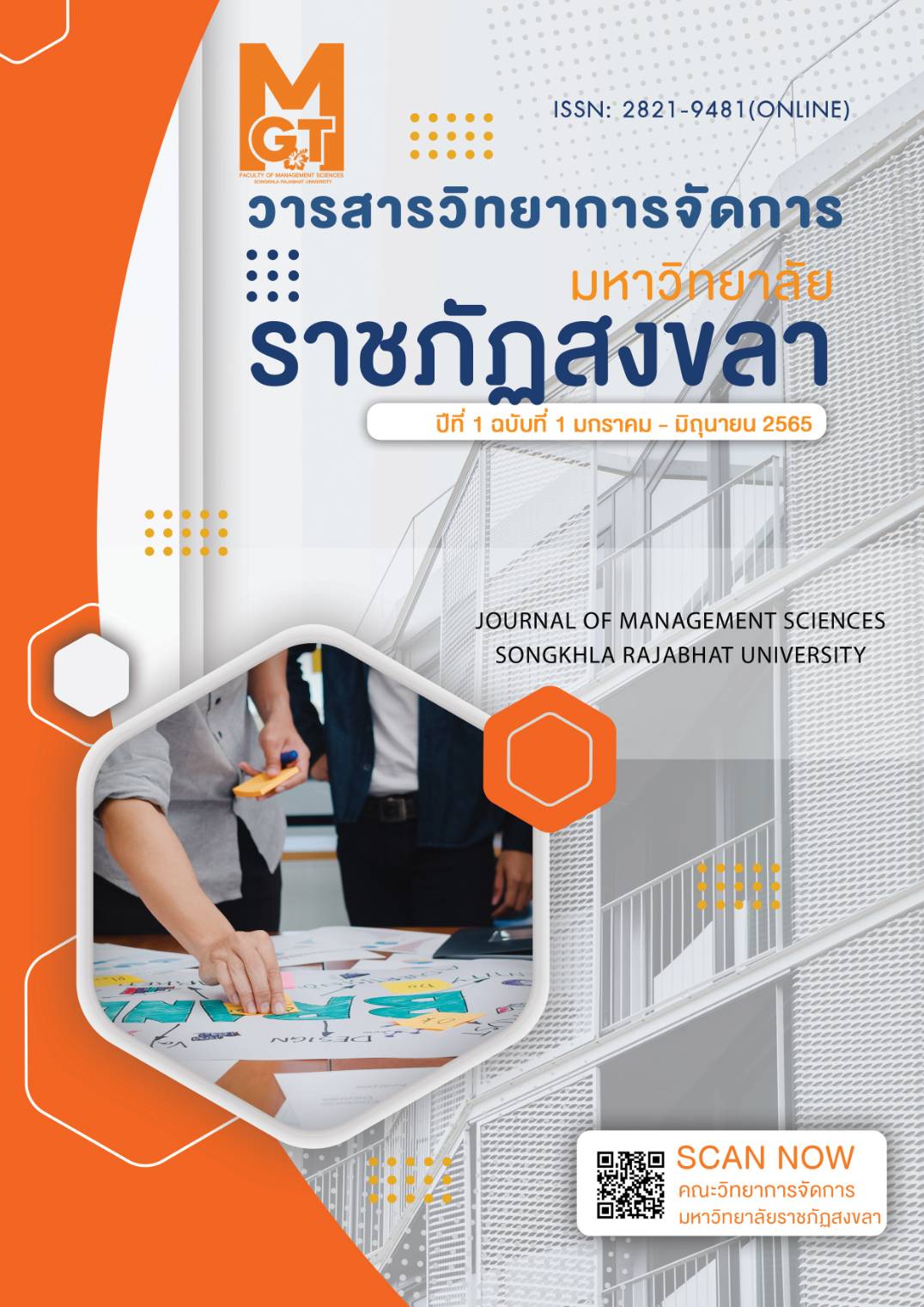Increasing Product Value การเพิ่มมูลค่าผลิตภัณฑ์ข้าวอินทรีย์และเพิ่มช่องทางการตลาดผ่านระบบพาณิชย์อิเล็กทรอนิกส์ของกลุ่มวิสาหกิจชุมชนข้าว จังหวัดศรีสะเกษ การเพิ่มมูลค่าสินค้า, แนวทางการพัฒนาผลิตภัณฑ์,ระบบพาณิชย์อิเล็กทรอนิกส์
Main Article Content
บทคัดย่อ
งานวิจัยนี้ศึกษาแนวทางการเพิ่มมูลค่าผลิตภัณฑ์ข้าวอินทรีย์ของกลุ่มวิสาหกิจชุมชนข้าวผักไหม จังหวัดศรีสะเกษ และพัฒนาระบบพาณิชย์อิเล็กทรอนิกส์ รูปแบบการวิจัยประยุกต์ แบ่งเป็น 2 ระยะตามวัตถุประสงค์การวิจัย กลุ่มเป้าหมาย คือ กลุ่มวิสาหกิจชุมชนข้าวผักไหม เครื่องมือวิจัย คือ แบบสอบถาม แบบสัมภาษณ์เชิงลึก การสนทนากลุ่ม การสังเกตแบบมีส่วนร่วม แบบประเมิน ใช้โปรแกรมสำเร็จรูปและโปรแกรมกราฟิกพัฒนาระบบพาณิชย์อิเล็กทรอนิกส์ วิเคราะห์เชิงคุณภาพและนำเสนอเชิงพรรณนาความ วิเคราะห์หาค่าร้อยละ ค่าเฉลี่ย ค่าเบี่ยงเบนมาตรฐาน ผลการวิจัย ดังนี้
ระยะที่ 1 พบว่า แนวทางเพิ่มมูลค่าผลิตภัณฑ์ มีแนวทางดังนี้ 1) การสร้างภาพลักษณ์ให้กับผลิตภัณฑ์ โดย (1) การสร้างตราสินค้าและบรรจุภัณฑ์ที่มาตรฐาน (2) การสร้างความเป็นจุดเด่นด้านผลิตภัณฑ์อินทรีย์ ปลอดสารเคมีและมีคุณภาพรับรอง GAP และ Organic 2) การแปรรูปผลิตภัณฑ์ข้าวอินทรีย์ พบว่า แปรรูปข้าวอินทรีย์เป็นเครื่องสำอาง เช่น สบู่ และเซรั่มและในรูปแบบของขนมพื้นบ้านที่ผลิตจากข้าว
ระยะ 2 พบว่า ระบบพาณิชย์อิเล็กทรอนิกส์ มีองค์ประกอบ ดังนี้ 1) หน้าแรก 2) ประวัติ 3) กิจกรรมโครงการชุมชน 4) สินค้าของเรา 5) การสั่งซื้อ 6) การชำระเงิน 7) ติดต่อเรา ทั้งหมดเป็นส่วนสำคัญในการทำธุรกิจซื้อขายสินค้าผ่านอินเทอร์เน็ต ผลการประเมินพาณิชย์อิเล็กทรอนิกส์จากผู้ใช้งาน พบว่า ความพึงพอใจภาพรวมระดับมาก (=4.39) มีการออกแบบระบบตามกระบวนการออกแบบต้นแบบ (Prototype) เน้นการออกแบบเรียบง่ายเหมาะกับผลิตภัณฑ์ของชุมชนท้องถิ่นทำให้ภาพรวมอยู่ในระดับเป็นที่พึงพอใจ
Article Details
เอกสารอ้างอิง
Anselmsson, J., Bondesson, N. V. and Johansson. U. (2014). Brand image and customers’ willingness to pay a price premium for food brands. Journal of Product & Brand Management 23(2), 90-102.
Biel, A. L. (1992). How brand image drives brand equity. Journal of Advertising Research 32(6), 6-12.
Boonmak, S. (2014). What is E-Business. [Access March 17, 2021]. Available from http://www.makemany.com/how-to/e-business.html.
Boonpisuttinant, K. (2022). Cosmetics from organic Riceberry extracts. Available. https://www.thailandtechshow.com/view_techno.php?id=96. [2022, March 1].
Dararuang, K. (2017). Development of product and market strategy for ban kao lame community enterprise, Nakhonsawan Province. Journal of Suthiparithat 31(100), 131-143.
Jaruwan, J., & D. Kositanon. (2012). Behavior and Key Marketing Communication Factors that Influence Purchasing Behavior From Social Media Marketing Communication. Panyapiwat Journal. 3(2), 38-49.
Jaturongkul, A. (2003). Marketing Management. Thammasat University: Bangkok.
Kiangkham, D. (2010). Manual website builder. [Accessed November, 2021]. Available from: http://dvision.in.th/what-to- know/xmlsitemap.html
Kotler, P., & Armstrong, G. Principles of Marketing. New Jersey: Prentice Hall. (2002) Phil Carpenter: E-Brandings, Harvard Business School Press.
Laolapa, P., Chongwuthiwet, K., Mahakhan, P., & Yuangklang, C. (2013). Knowledge management of farmers in the Northeastern region. Knowledge Management of Agriculturists in the Northeasern Region. Education Journal Silpakorn University 10 (2), 69-81.
Makhakvun, C. (2019). Guidelines for Creating Value Added to Local Rice Products Corresponding to the Current context and way of consumption of consumers in Rasi Salai District, Sisaket Province. Journal of Fine and Applied Arts Khon Kaen University 12(1), 152-179.
Munwicha, C., Anucharn, A, Phanpanasakul, A., Rungklin, C., Supaphong, K., & Thipayasothon, R. (2016). Development of E-Commerce Prototype for Woven Product from Krajood (Lepironia articulata (Retz.) Domin) of Baan Tha-le Noi, Phattalung Province. The 7th National and International Hat Yai Conference. 23 June 2016. Hat Yai University.
Narin, W & Narot P. (2012). Improving the potential of farming networks to increase the quality of jasmine rice: A case stady of sustainable agriculture network in Tambon Nong Khaen of Pathumrat district, Roi Ed province. Journal of the Graduate School of Asia 7(1), 130-138.
Phakdiwatanakul, K., & Kanchanasuwan, T. (2014). Electronic commerce scriptures. Bangkok: KTP. Comp and Const.
Rojanasaeng C. (2002). Introduction to Marketing of teaching materials for the subject of Marketing, Products, Agriculture and the Thai Economy, Volume 1, Unit 1, Department of Management Science. Nonthaburi: Sukhothai Thammathirat Open University.
Rundh, B. (2009). Packaging design: creating competitive advantage with product packaging. British Food Journal. 11(9), 988-1002.
Soponrat, L. and S. Anantachat. (2005). Influence of package design on consumer decision making. Journal of Communication Arts Chulalongkorn University 23(1), 52-76.
Tangtrakul, P. (2012). Rice Processing to Create Value Added at the 2nd National Rice Conference, New Dimensions, Researching Thai Rice for Climate Change and Free Market Opening of ASEAN. Bangkok: National Science and Technology Development Agency. (P. 67).
Ueapattanakit, T. (2010). Rice Trading Online System. Master of Science program Information Technology. Mahanakorn University.
Vikromprasit, S. (2015). Business Plan Management of Morhom Cloth Tambon Tunghong, City District, Phrae Province. Academic Journal Uttaradit Rajabhat University 10(1), 197-212.
Wongmonta, S. (2006). Marketing is Value Creation. [Online]. Available. https://www.manager.co.th/Business/ViewNews.aspx?NewsID=9490000114546. [2018, July 17].


